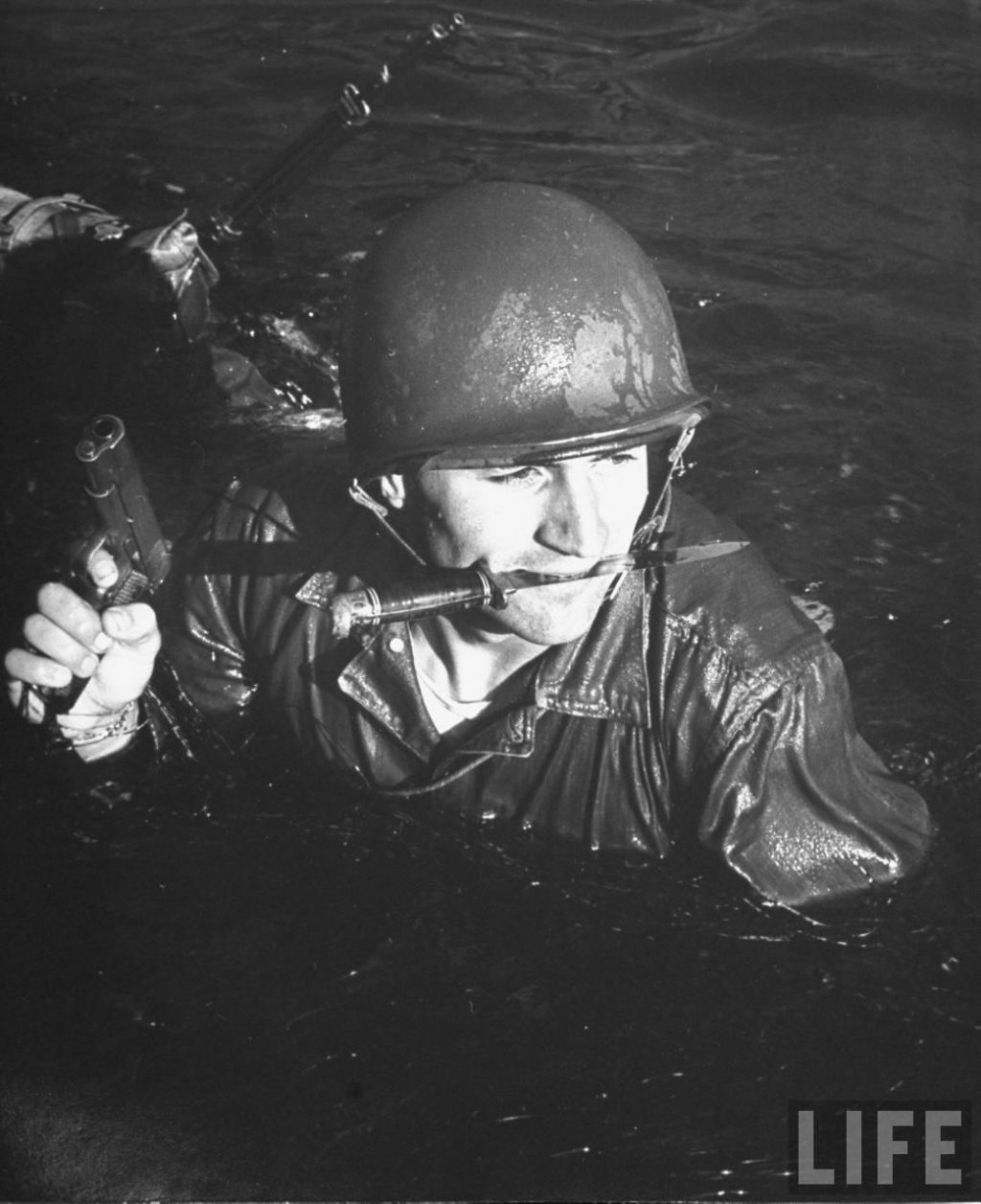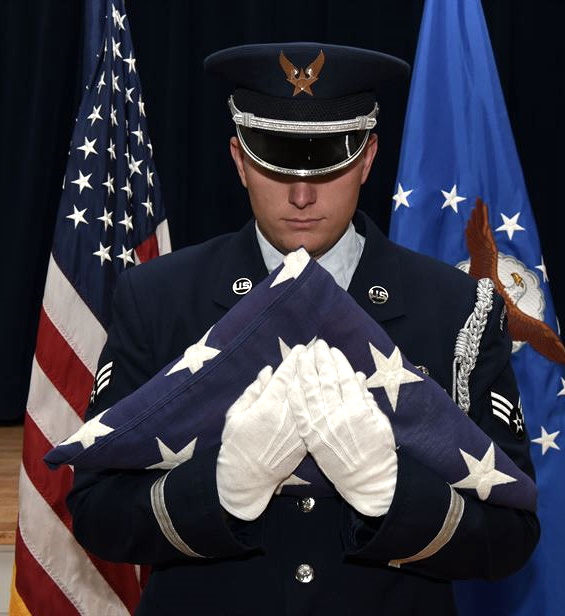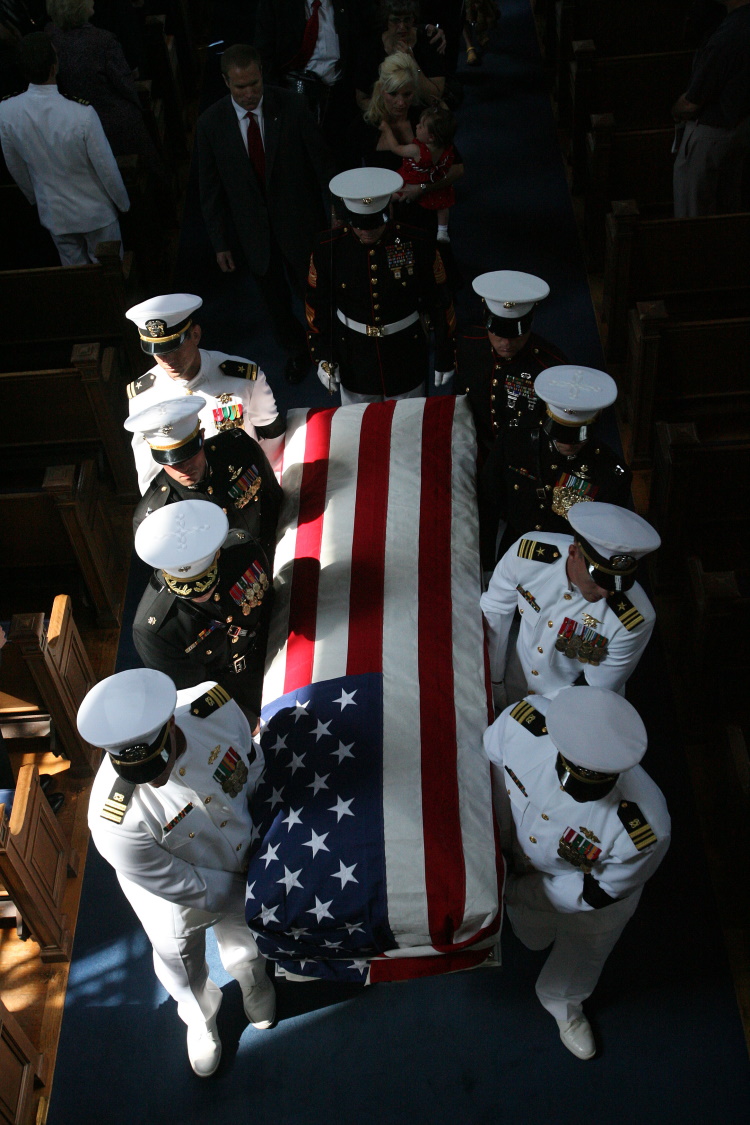TABLES OF ORGANIZATION (TO&E)
When the Plans and Policies Division at Headquarters made its initial request in May 1940 for input on a Marine parachute program, it suggested that planners work with an organization for one infantry battalion reinforced by a platoon of pack howitzers and some light antiaircraft and anti-tank weapons. In late October 1940, the Commandant determined that each infantry regiment would train one of its battalions as air infantry, with one company of each such battalion prepared to conduct parachute operations. He estimated that would require 750 parachutists, about the number originally envisioned for a separate battalion. However, those men would now double as regular infantry and help fill spaces in the chronically undermanned line units. That idea did not last long and the Corps soon began talking about multiple battalions specializing in parachute operations. The first official parachute table of organization, issued in March 1941, authorized a battalion of three-line companies and a headquarters unit. The line companies consisted of a weapons platoon (three 60-MM mortars and three light machine guns), three rifle platoons of three 10-man squads (armed with six rifles, two Browning Automatic Rifles (BARs), and two Thompson sub-machine guns).
 The standard squad for the regular infantry unit at the time was nine men, with eight rifles and a single BAR. The 34 officers and 832 enlisted men of an infantry battalion dwarfed the 24 officers and 508 enlisted men of a parachute battalion, with the main difference coming from the former’s company of heavy weapons. The parachutists lacked the large-caliber mortars, water-cooled machine guns, and antitank guns possessed by the infantry, but made up for it in part with a much greater preponderance of individual automatic weapons. Once the US entered the war, the parachute units went through the same process of experimentation in structure as the rest of the Corps. A 1942 revision to the tables did away with the weapons platoons, distributing one 60-MM mortar to each rifle platoon and getting rid of the machine guns. The latter change was not as drastic as it might appear since each rifle squad was to have three Johnson light machine guns. The remaining riflemen were supposed to carry Reising sub-machine guns. This mix of automatic weapons theoretically gave the parachute squad an immense amount of firepower. As things turned out, the Johnson took a long time to get to the forces in the field and the Reising proved to be an unreliable weapon.
The standard squad for the regular infantry unit at the time was nine men, with eight rifles and a single BAR. The 34 officers and 832 enlisted men of an infantry battalion dwarfed the 24 officers and 508 enlisted men of a parachute battalion, with the main difference coming from the former’s company of heavy weapons. The parachutists lacked the large-caliber mortars, water-cooled machine guns, and antitank guns possessed by the infantry, but made up for it in part with a much greater preponderance of individual automatic weapons. Once the US entered the war, the parachute units went through the same process of experimentation in structure as the rest of the Corps. A 1942 revision to the tables did away with the weapons platoons, distributing one 60-MM mortar to each rifle platoon and getting rid of the machine guns. The latter change was not as drastic as it might appear since each rifle squad was to have three Johnson light machine guns. The remaining riflemen were supposed to carry Reising sub-machine guns. This mix of automatic weapons theoretically gave the parachute squad an immense amount of firepower. As things turned out, the Johnson took a long time to get to the forces in the field and the Reising proved to be an unreliable weapon.
The 1943 tables created a regimental structure consisting of a headquarters company and a weapons company. The latter unit of seven officers and 172 men served as a pool of extra firepower for the lightly armed battalions. The company was supposed to field four 81-MM mortars, one dozen each of the air-cooled and water-cooled .30-caliber machine guns, two .50-caliber machine guns, two bazookas, and eight grenade launchers. Headquarters also authorized a change in the size of the battalions from 24 officers and 508 enlisted Marines to 23 officers and 568 enlisted. The additional personnel was all in the headquarters company, though 33 of them formed a demolitions platoon that did add directly to the battalion’s combat power. Beyond that, I MAC allowed the line companies to reestablish weapons platoons exactly like those deleted in 1942. That move increased the authorized strength of each battalion by another three officers and 87 enlisted men (though manpower for these units was often taken out of hiding). The new rifle squad of 11 men was supposed to have three Johnson machine guns, three Johnson rifles, and five Reisings, but by this time the parachute regiment informally had adopted the fire team concept of three three-man teams and a squad leader.
MILITARY ACCIDENTS
 Since the end of World War Two, everything has been done to tow special troops under the projectors and make peoples believe that only these troops were having a very dangerous preparation to achieve their goals, being a Pilot, a Paratroopers, a Marine Raider and so on. I have compiled a small list of Military Naval accidents that happened during training sessions or during combat without being the result of enemy action. While typing this archive I thought that citing all these long-forgotten names would be a perfect way to remember them!
Since the end of World War Two, everything has been done to tow special troops under the projectors and make peoples believe that only these troops were having a very dangerous preparation to achieve their goals, being a Pilot, a Paratroopers, a Marine Raider and so on. I have compiled a small list of Military Naval accidents that happened during training sessions or during combat without being the result of enemy action. While typing this archive I thought that citing all these long-forgotten names would be a perfect way to remember them!
In 1940, 40 sailors were killed in flight accidents during the year. On January 31, 1940, on the USS New York (BB-34), Seaman 2 class James Orville Epperson was accidentally struck by a loading tray inside the N°2 turret and fell into the gun pit. Epperson was then crushed by a 14-inch shell that fell in immediately afterward. While en route from San Diego to Pensacola on January 2, 1940, one PBY-5 aircraft encountered severe weather over Texas and 5 members of the crew were forced to bail out. One parachute failed and Aviation Machinist’s Mate 2 class William F. Percich fell to his death. On January 4, 1940, a twin-engine transport plane Douglas R2D-1, which had rescued four crewmen who had bailed out of the PBY on January 2, crashed and burned while trying to land at San Diego. Four officers and three enlisted men of the R2D-1 and the four PBY crew all died in the crash.
During the year of 1941, 110 sailors were killed in-flight accidents. On June 18, on board the USS California (BB-44) Seaman 2 class Norris Rabelee Wilson died of injuries suffered on the shell deck of the N°4 turret when he was caught between the rotating part of that turret and a secured service shell. On June 19, the USS O-9 (SS-70) submarine got lost during a deep submergence test off New London (Connecticut). The crew, 33 men, drowned. On August 14, the submarine chaser USS PC-457 sank after colliding with the merchant ship SS Norluna north of San Juan (Puerto Rico). Fireman 2 class Francis Carl McKenna, USNR, and Seaman 1 class Howard Dorsey Osborn, USNR, were both killed.
Between December 7, 1941, (Pearl Harbor) and December 29, 1946, 1469 enlisted men were killed in air combat. If 460 were killed in action on the ground, 3303 enlisted men were killed in flight accidents. On January 24, 1942, the USS S-26 (SS-131) accidentally rammed and sunk by PC-460. 46 men were killed. Six days before, on January 18, the USS Truxtun (DD-229) and the USS Pollux (AKS-2) ran aground during a storm in Placenta Bay (Newfoundland), and broke up in the surf. 204 men were killed. On June 12, 1943, the USS R-12 (SS-89) sank after flooding in the battery compartment, taking 42 men of the crew to the bottom of the sea.
On September 2, 1943, a TBF Avenger splashed on takeoff from the USS Belleau Wood (CVL-24) in the Eastern Pacific. The radioman was killed when the depth charge activated and exploded. On Oct 6, an F6F Hellcat crashed on the deck of USS Belleau Wood (CVL-24) during the Wake Island Raid, fire and explosion killed 4 flight deck crew. A little later, on October 16, the USS Moonstone (PYc-9) was lost after a collision with the USS Greer (DD-145). One man was killed. On November 20, the USS Mississippi (BB-41), while in combat operations off Makin (Gilbert Islands), suffered a cordite explosion in the N°2 14-inch gun turret, 19 men were injured and 43 were killed. Three days after the new year, on January 3, 1944, suffering a series of ammunition explosions, the USS Turner (DD-648) sank in the New York Harbor. 138 men were killed and 60 injured. On January 13, 1944, an F6F Hellcat crashed through the barrier on the flight deck of the USS Bataan (CVL-29) during one training operation en route to Trinidad. Three flight deck crew killed. An accidental ordnance blast on the LST-353 sets off cataclysmic ammunition explosions at West Loch (Pearl Harbor). Six tank landing ships (LST-39, LST-43, LST-69, LST-179, LST-353, LST-480), three tank landing craft (LCT-961, LCT-963, LCT-983), and 17 track landing vehicles (LVTs) were destroyed in these explosions and fires. 163 men were killed and 396 injured. On July 17, again an ammunition explosion on Pier #1 at the US Naval Magazine, in Port Chicago. The tremendous blast killed 1 Marine, 5 Coast Guard, and 73 civilians, 390 others were also injured including 233 African-American Navy personnel.
On August 12, Lt Joseph P. Kennedy, the older brother of John F. Kennedy, was killed with his co-pilot in a mid-air explosion after taking off from England in a PB4Y from Special Attack Unit One (SAU-1). Following manual takeoff, they were supposed to parachute out over the English Channel while the radio-controlled explosive-filled drone proceeded to attack a German V-2 missile-launching site. Possible causes include faulty wiring or FM signals from a nearby transmitter. The USS Warrington (DD-383) sank on September 13, 1944, during a hurricane off Florida. 248 men drowned. November 10, 1944, the USS Mount Hood (AE-11), with a cargo of 3800 tons of ordnance, suddenly exploded in Seeadler Harbor (Admiralty Islands), creating a mushroom cloud that rose 7000 feet into the air. The tremendous explosion ripped a 300-foot long, 50-foot wide, and 40-foot deep crater into the ocean floor. Metal fragments caused many casualties and severe damage to nearby ships and twenty-two small boats and landing craft were sunk, destroyed, or damaged beyond repair. Casualties included 45 known dead, 327 missing, and 371 injured. The only survivors of Mount Hood’s 318-man crew were a shore party of 18 sailors who saw a flash from the harbor followed by two quick explosions.
On December 18, 1944, two days after the beginning of the Battle of the Bulge in Belgium, Task Force 38 was struck by a typhoon off the Philippines. The destroyers USS Hull (DD-350), the USS Spence (DD-512), and the USS Monaghan (DD-354) capsized and sank. 28 other vessels were damaged and about 790 men were killed and 80 others were injured. On January 24, 1945, the USS Extractor (ARS-15) was torpedoed and sank by the USS Guardfish (SS-217) in case of mistaken identification. Six men were killed. On June 5, 1945, Task Force 38 was again struck by a typhoon in the Okinawa area. 36 ships were damaged and at least 6 men were killed. On June 7, 1945, while replenishing ordnance in Leyte Gulf, the aircraft carrier Randolph (CV-15) was buzzed by an Army P-38 Mustang that subsequently crashed her forward flight deck. The explosion and the following fire killed 14 men. On the USS Bataan (CVL-29) on July 4, 1945, one arresting gear cable parted, killing one flight deck crew during flight operations. Another typhoon passed within 15 miles of Okinawa, severely damaging ships in Buckner Bay anchorage. 12 small ships and landing craft sunk while 222 others beached. 73 men were killed. On December 5, 1945, Flight 19, comprised of 5 TBM Avengers on a training flight from Fort Lauderdale (Florida), strayed off course, ran out of fuel and crashed into heavy seas. 14 men were killed and during the subsequent search, which involved hundreds of ships and aircraft, a PBM Mariner with a crew of 13 also crashed with no survivors.
Despite the inherent danger of jumping out of a plane high above the ground, the Marine parachute program had very few accidents. That may have been due in part to the system initially used to prepare the parachutes. From the very first training class, the Corps set the standard that each jumper would pack his own parachute. In addition, a trained rigger supervised the task and had to sign his name on the tag before the parachute was certified for use. Later this procedure was dropped and riggers packed all parachutes for use in the FMF, but by that time Marines were making very few jumps. The record indicates only one Marine accident that may have involved a malfunctioning parachute.
During training in New Caledonia, one man’s main parachute failed to open properly. He pulled the ripcord on his reserve, but it just had time to begin deploying when he hit the ground. Observers thought, however, that the main parachute did not deploy because the suspension lines were tangled up in the Marine’s rifle. Three other men died in Marine Corps jumping accidents not related to the performance of the parachute. Two men drowned after landing in water; one at Norfolk (Virginia), and one at New River (North Carolina). The final fatality occurred when a New River trainee lost his nerve just as he approached the door of the plane. He moved out of the line of jumpers, but his static line became tangled with the next man to go out. The non-jumper’s parachute opened while he was inside the plane and the billowing chute slammed him against the aircraft body hard enough to wreck the door and sever his spine.
The most unusual accident occurred near San Diego (California), on May 15, 1941. 2/Lt Walter A. Osipoff and 11 enlisted men of Able Co were making a practice jump over Kearney Mesa. Everyone else had exited the plane and he threw out a cargo pack, which possibly tangled in his static line. His parachute opened prematurely while he was still in the door of the plane; it billowed outside the aircraft and pulled him out, but the canopy and suspension lines tangled in the bundle of static lines streaming beside the transport. For a moment the cargo pack, Osipoff, and his partially opened parachute were all suspended from the cable that held the static lines. Under this combined load the bracket holding one end of the cable gave way and it streamed out the door. The cargo pack fell away, but Osipoff and his parachute remained dangling from the cable and static lines, suspended behind the plane’s tail. The accident also ruined his reserve chute and ripped away from the part of his harness attached to his chest. He ended up being dragged through the air feet-first, held only by the leg straps. The crew of the plane attempted to pull him in but could not do so. Since the transport had no radio communications, the pilot flew it over the field at North Island to attract attention. Two Navy test pilots, Lt William W. Lowery, and Aviation Chief Machinist’s Mate John R. McCants, saw the problem and took off in a SOC-1, an open-cockpit, two-seats biplane. The SOC-1 flew just below and behind the transport, while McCants attempted to pull Osipoff into his cockpit.
It was an incredible display of flying skill that gave the necessity  to avoid hitting the Marine lieutenant with the SOC-1’s propellers. McCants finally succeeded in getting him headfirst into the plane, though his legs dangled outside. Before McCants could cut the shroud lines, bumpy air pushed the biplane up and its propellers did the job (chopping off 12 inches of the tail cone of the transport in the process). Lowery landed his aircraft as McCants maintained his tenuous grip on the Marine parachutist. Osipoff suffered severe cuts and bruises and a fractured vertebra. He spent three months in a body cast, but fully recovered and returned to jump status. Lowery and McCants received Distinguished Flying Crosses for their successful rescue.
to avoid hitting the Marine lieutenant with the SOC-1’s propellers. McCants finally succeeded in getting him headfirst into the plane, though his legs dangled outside. Before McCants could cut the shroud lines, bumpy air pushed the biplane up and its propellers did the job (chopping off 12 inches of the tail cone of the transport in the process). Lowery landed his aircraft as McCants maintained his tenuous grip on the Marine parachutist. Osipoff suffered severe cuts and bruises and a fractured vertebra. He spent three months in a body cast, but fully recovered and returned to jump status. Lowery and McCants received Distinguished Flying Crosses for their successful rescue.










